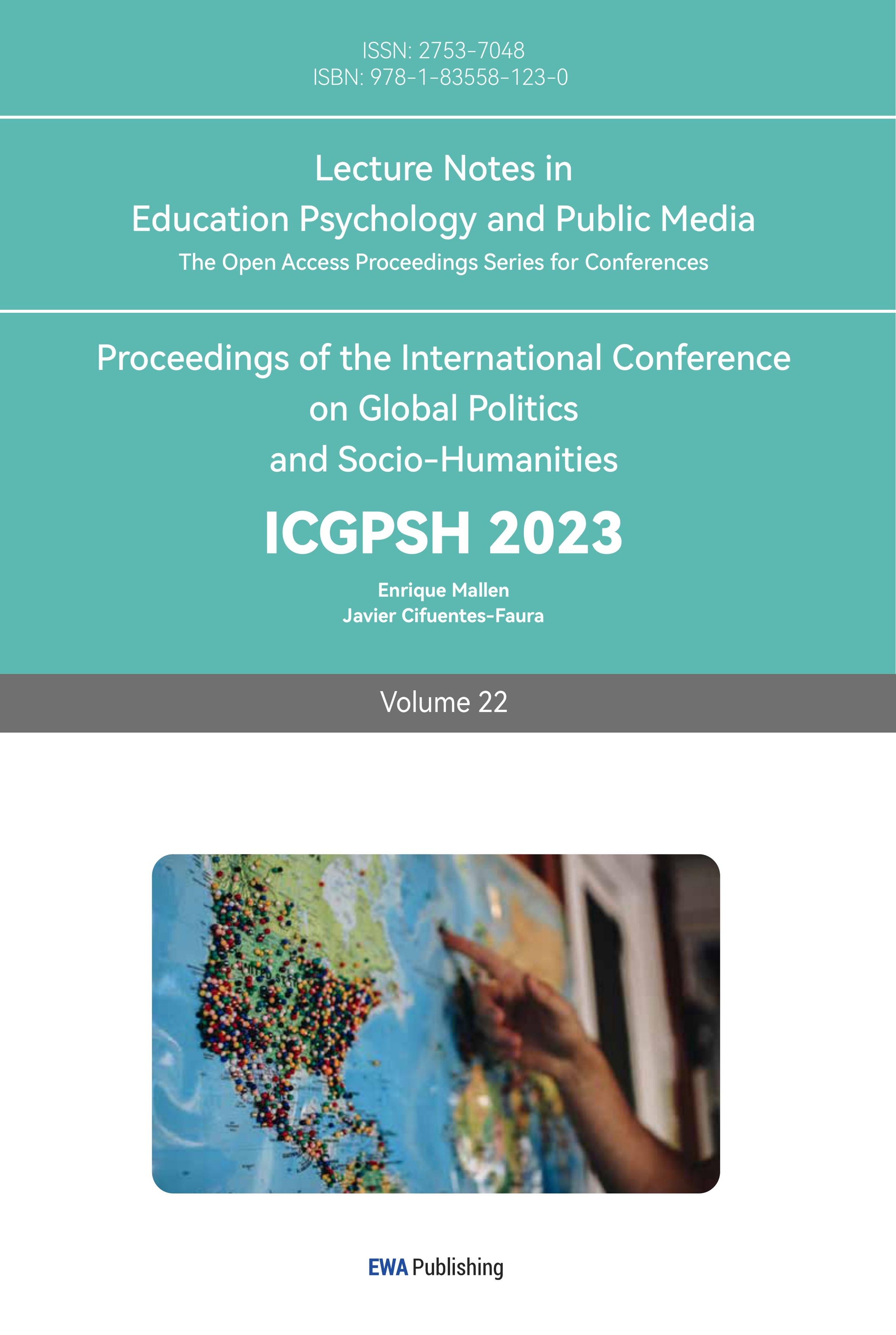References
[1]. K. Kumar and G. S. M. Thakur, “Advanced applications of neural networks and artificial intelligence: A review,” International journal of information technology and computer science, vol. 4, no. 6, pp. 57–68, 2012.View at: Google Scholar.
[2]. Duan Shifei,Gong Guoqian.Artificial Intelligence Education Application Policy in An International Comparative Perspective[J].Modern Educational Technology,2019,29(03):11-17.
[3]. Liu Jin.Comparative Study on Global AI Talent Training Policies: Take China, The United States, The United Kingdom and Canada As An Example[J]. Research trends of domestic higher education teaching, 2020(13):3.
[4]. Liu Ping.Japan’s New Round of AI Development Strategy —— Talent, Research and Development and Social Real Application[J]. Modern Japanese Economy,2020,39(6):40-51.
[5]. Zeng Haijun, Zhang Yu, Miao Miao.Ensuring AI as a Common Good to Promote the Systematic Transformation in Education[J].National Engineering Research Center of Cyberlearning and Intelligent Technology 2022,(08):01-08.
[6]. Shi Qiuheng,Chang Jingyan.Strategic Characteristics and Institutional Construction of Artificial Intelligence in Enabling High-quality Higher Education[J].Journal of Xi’an Jiaotong University(Social Sciences),2023,(05):01-13.
[7]. Chen Keye,Lin Liang.Artificial Intelligence Enables Vocational Education Reform: Inherent Logic, Realistic Challenges and The Times[J].Education and Career,2023,(08):102-107.
[8]. Li Shijin,Hu Yiling,Gu Xiaoqing.How to Get Out of the Dilemma of Artificial Intelligence Education Risk: Phenomenon, Cause and Response[J].East China Normal University (ECNU),2021.07.003:19-25.
[9]. Wu Hejiang,Tu Yanguo,Tan Lisha.Education Risks and Its Avoidance in the Era of Artificial Intelligence[J]. XDJYJS, 2020 (4) :18-24.
[10]. European Union.2018. General Data Protection Regulation).Available at: https://gdpr-info.eu (Accessed 29 July 2023).
[11]. European Union. 2019. Ethics guidelines for trustworthy AI. Available at: https://ec.europa.eu/digital-single-market/en/news/ethics-guidelines-trustworthy-ai (Accessed 29 July 2023).
[12]. IBM, n.d.. IBM Research-Africa. Available at: https://www.research.ibm.com/labs/africa (ccessed 29 July 2023).
[13]. Mavrikis, M. 2015b. ITalk2Learn. Available at: https://www. italk2learn.com (Accessed 29 July 2023).
[14]. SmartMusic, n.d.. SmartMusic. Available at: https://www. smartmusic.com (Accessed 29 July 2023).
[15]. Tencent Research Institute.2022. 2022 Blue Book on Artificial Intelligence Education: Current Status, Challenges and Development Recommendations. Available at:https://new.qq.com/ rain/a/20220324A097GB00 (Accessed 29 July 2023).
[16]. ILO.2019. Work for a Brighter Future: Global Commission on the Future of Work. Available at: https://www.ilo.org/wcmsp5/groups/public/---dgreports/---cabinet/documents/publication/wcms_662410.pdf (Accessed 29 July 2023).
Cite this article
Luo,H.;Li,Y.;Yu,H. (2023). Analysis of Policy Applications of Artificial Intelligence in Education. Lecture Notes in Education Psychology and Public Media,22,295-302.
Data availability
The datasets used and/or analyzed during the current study will be available from the authors upon reasonable request.
Disclaimer/Publisher's Note
The statements, opinions and data contained in all publications are solely those of the individual author(s) and contributor(s) and not of EWA Publishing and/or the editor(s). EWA Publishing and/or the editor(s) disclaim responsibility for any injury to people or property resulting from any ideas, methods, instructions or products referred to in the content.
About volume
Volume title: Proceedings of the International Conference on Global Politics and Socio-Humanities
© 2024 by the author(s). Licensee EWA Publishing, Oxford, UK. This article is an open access article distributed under the terms and
conditions of the Creative Commons Attribution (CC BY) license. Authors who
publish this series agree to the following terms:
1. Authors retain copyright and grant the series right of first publication with the work simultaneously licensed under a Creative Commons
Attribution License that allows others to share the work with an acknowledgment of the work's authorship and initial publication in this
series.
2. Authors are able to enter into separate, additional contractual arrangements for the non-exclusive distribution of the series's published
version of the work (e.g., post it to an institutional repository or publish it in a book), with an acknowledgment of its initial
publication in this series.
3. Authors are permitted and encouraged to post their work online (e.g., in institutional repositories or on their website) prior to and
during the submission process, as it can lead to productive exchanges, as well as earlier and greater citation of published work (See
Open access policy for details).
References
[1]. K. Kumar and G. S. M. Thakur, “Advanced applications of neural networks and artificial intelligence: A review,” International journal of information technology and computer science, vol. 4, no. 6, pp. 57–68, 2012.View at: Google Scholar.
[2]. Duan Shifei,Gong Guoqian.Artificial Intelligence Education Application Policy in An International Comparative Perspective[J].Modern Educational Technology,2019,29(03):11-17.
[3]. Liu Jin.Comparative Study on Global AI Talent Training Policies: Take China, The United States, The United Kingdom and Canada As An Example[J]. Research trends of domestic higher education teaching, 2020(13):3.
[4]. Liu Ping.Japan’s New Round of AI Development Strategy —— Talent, Research and Development and Social Real Application[J]. Modern Japanese Economy,2020,39(6):40-51.
[5]. Zeng Haijun, Zhang Yu, Miao Miao.Ensuring AI as a Common Good to Promote the Systematic Transformation in Education[J].National Engineering Research Center of Cyberlearning and Intelligent Technology 2022,(08):01-08.
[6]. Shi Qiuheng,Chang Jingyan.Strategic Characteristics and Institutional Construction of Artificial Intelligence in Enabling High-quality Higher Education[J].Journal of Xi’an Jiaotong University(Social Sciences),2023,(05):01-13.
[7]. Chen Keye,Lin Liang.Artificial Intelligence Enables Vocational Education Reform: Inherent Logic, Realistic Challenges and The Times[J].Education and Career,2023,(08):102-107.
[8]. Li Shijin,Hu Yiling,Gu Xiaoqing.How to Get Out of the Dilemma of Artificial Intelligence Education Risk: Phenomenon, Cause and Response[J].East China Normal University (ECNU),2021.07.003:19-25.
[9]. Wu Hejiang,Tu Yanguo,Tan Lisha.Education Risks and Its Avoidance in the Era of Artificial Intelligence[J]. XDJYJS, 2020 (4) :18-24.
[10]. European Union.2018. General Data Protection Regulation).Available at: https://gdpr-info.eu (Accessed 29 July 2023).
[11]. European Union. 2019. Ethics guidelines for trustworthy AI. Available at: https://ec.europa.eu/digital-single-market/en/news/ethics-guidelines-trustworthy-ai (Accessed 29 July 2023).
[12]. IBM, n.d.. IBM Research-Africa. Available at: https://www.research.ibm.com/labs/africa (ccessed 29 July 2023).
[13]. Mavrikis, M. 2015b. ITalk2Learn. Available at: https://www. italk2learn.com (Accessed 29 July 2023).
[14]. SmartMusic, n.d.. SmartMusic. Available at: https://www. smartmusic.com (Accessed 29 July 2023).
[15]. Tencent Research Institute.2022. 2022 Blue Book on Artificial Intelligence Education: Current Status, Challenges and Development Recommendations. Available at:https://new.qq.com/ rain/a/20220324A097GB00 (Accessed 29 July 2023).
[16]. ILO.2019. Work for a Brighter Future: Global Commission on the Future of Work. Available at: https://www.ilo.org/wcmsp5/groups/public/---dgreports/---cabinet/documents/publication/wcms_662410.pdf (Accessed 29 July 2023).









